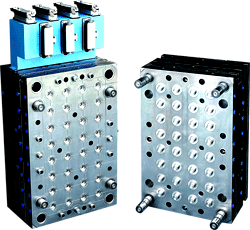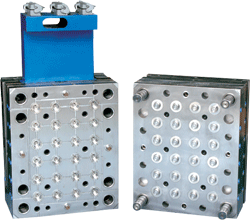There are basically four types of blow molding used in the production of plastic bottles, jugs and jars. These four types are: extrusion blow molding, injection blow molding, stretch blow molding and reheat and blow molding. Extrusion blow molding is perhaps the simplest type of blow molding, whereby a hot tube of plastic material is dropped from an extruder and captured in a water cooled mold. Once the molds are closed, air is injected through the top or the neck of the container; just as if one were blowing up a balloon. When the hot plastic material is blown up and touches the walls of the mold the material “freezes” and the container now maintains its rigid shape. There are various types of shuttle, reciprocating and wheel style machines for the production of extrusion blown bottles. Shuttle or reciprocating type machines can be used for small, medium and high volume production with wheel machines being the most efficient for huge volume production of certain resins.
Injection blow molding is part injection molding and part blow molding. With injection blow molding, the hot plastic material is first injected into a cavity where it encircles the blow stem, which is used to create the neck and establish the gram weight. The injected material is then carried to the next station on the machine, where it is blown up into the finished container as in the extrusion blow molding process above.
Injection blow molding is generally suitable for smaller containers and absolutely no handleware. Extrusion blow molding allows for a wide variety of container shapes, sizes and neck openings, as well as the production of handleware. Extrusion blown containers can also have their gram weights adjusted through an extremely wide range, whereas injection blown containers usually have a set gram weight which cannot be changed unless a whole new set of blow stems are built. Extrusion blow molds are generally much less expensive than injection blow molds and can be produced in a much shorter period of time.
Many people have heard about stretch blow molding in conjunction with P.E.T. bottles commonly used for water, juice and a variety of other products. There are two processes for stretch blow molded P.E.T. containers. In one process, the machinery involved injection molds a preform, which is then transferred within the machine to another station where it is blown and then ejected from the machine. This type of machinery is generally called injection stretch blow molding (ISBM) and usually requires large runs to justify the very large expense for the injection molds to create the preform and then the blow molds to finish the blowing of the container. This process is used for extremely high volume (multi-million) runs of items such as wide mouth peanut butter jars, narrow mouth water bottles, liquor bottles etc.
Another stretch blow process is commonly called reheat and blow (RHB). In this process, a preform is injection molded by an outside vendor. There are a number of companies who produce these “stock” preforms on a commercial basis. Factories buy the preforms and put them into a relatively simple machine which reheats it so that it can be blown. The value of this process is primarily that the blowing company does not have to purchase the injection molding equipment to blow a particular container, so long as a preform is available from a stock preform manufacturer. This process also allows access to a large catalog of existing preforms. Therefore, the major expense is now for the blow molds, which are much less expensive than the injection molds required for preforms.
There are, however, some drawbacks to this process. If you are unable to find a stock preform which will blow the container you want, you must either purchase injection molds and have your own private mold preforms injection molded, or you will have to forego this process. For either type of stretch blow molding, handleware is not a possibility at this stage of development. The stretch blow molding process does offer the ability to produce fairly lightweight containers with very high impact resistance and, in some cases, superior chemical resistance.
Whether using the injection stretch blow molding process or the reheat and blow process, an important part of the process is the mechanical stretching of the preform during the molding process. The preform is stretched with a “stretch rod.” This stretching helps to increase the impact resistance of the container and also helps to produce a very thin walled container.
The extrusion blow molding process allows for the production of bottles in a wide variety of materials, including but not limited to: HDPE, LDPE, PP, PVC, BAREX?, P.E.T., K Resin, P.E.T.G., and Polycarbonate. As noted above, a wide variety of shapes (including handleware), sizes and necks are available. Injection blow molding allows for the production of bottles in a variety of materials, including but not limited to: HDPE, LDPE, PP, PVC, BAREX?, P.E.T., and Polycarbonate.
Besides the P.E.T. noted above for stretch blow molding, a number of other materials have been stretch blown, including polypropylene. As time goes on and technology moves forward, more materials will lend themselves to stretch blow molding as their molecular structures are altered to suit this process.
The decision as to which process will be used is based upon the desired appearance (clear or not), whether chemical or impact resistant is desired, and the desired cost/benefit relationship. The ultimate choice of materials and processes is also based upon the cost of the tooling involved and the sizes of the production runs. Some materials lend themselves to certain types of decorating better than others and some to certain types of decorating to the exclusion of others.
Listed below are representative brands of some types of the machinery we have discussed above. This list is not all-inclusive and you will find additional brands by looking through this and other packaging industry journals and magazines.
For shuttle extrusion type machines Bekum, Battenfeld/Fischer, and Hayssen are probably the best known in the United States. For injection blow molding machines JOMAR is a well known brand. For stretch blow and reheat and blow type machines there are Sidel, Nissei and other machines produced by Johnson Controls and others. For wheel machines you might wish to contact Johnson Controls or Wilmington Machinery.
 .
.